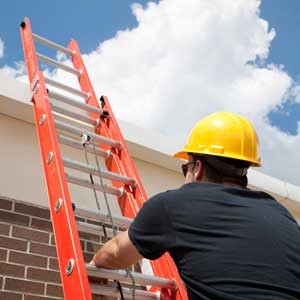Maintain safety when working on ladders

Employees face many dangers when they working on ladders. Companies that hire workers to complete projects that involve alteration, construction, decorating, demolition, repair, or painting must follow safety regulations established by the Occupational Safety and Health Administration (OSHA). Those rules include:
• Maintain ladders and ensure they are free of grease, oil, and other slipping hazards
• Do not load ladders beyond the manufacturer's rated capacity
• Use ladders for their designated purpose only
• Ensure ladders are used only on stable, level surfaces
• Avoid using ladders on slippery surfaces unless they are secured or provided with slip-resistant feet to prevent accidental movement. Do not use slip-resistant feet as a substitute for exercising care when holding, lashing, or placing ladders on slippery surfaces
• Secure ladders placed in high-traffic areas such as doorways, driveways, passageways, or where they can be displaced by workplace activities. If possible, use a barricade to keep activity or traffic away from the ladder
• Keep areas near the top and bottom of ladders clear
• Do not extend, move, or shift ladders when they are in use
• Use ladders that feature nonconductive side rails if workers could potentially come into contact with exposed energized electrical equipment
• When moving up or down, always face the ladder
• Use at least one hand to grip the ladder when climbing
• Do not carry objects or loads that are unsteady and could cause workers to lose their balance or fall
• Place ladder rungs, cleats, and steps so that they are level, parallel, and uniformly spaced
• Ensure that rungs, cleats, and steps of portable and fixed ladders are spaced between 10 and 14 inches apart along the ladder's side rails. The rods must also be put between 8 and 12 inches apart from the center of these bars
• Rungs, cleats and steps at the base section of extension trestle ladders must be set up between 8 and 18 inches apart. The rung spacing on the extension section must be established between 6 and 12 inches
• Do not tie or fasten ladders together unless they are specifically designed for that purpose
• If two or more separate ladders are used to reach an elevated work area, they must be offset with a platform or landing between them unless portable ladders are used to gain access to fixed ladders
• Ladder components must be smooth to help prevent snagging of clothing and injury from lacerations or punctures
• If workers use wood ladders, do not coat the ladders with any opaque covering except for identification or warning labels, which can be placed on one face of a side rail
• When joining side rails, the resulting side rail must be comparable in strength to a one piece rail made of the same material
When employees understand the risks and dangers involved in their jobs, they can maintain safety more effectively. Ensure employee safety when using ladders by providing training and supplying safety products such as fall protection and hard hats.



